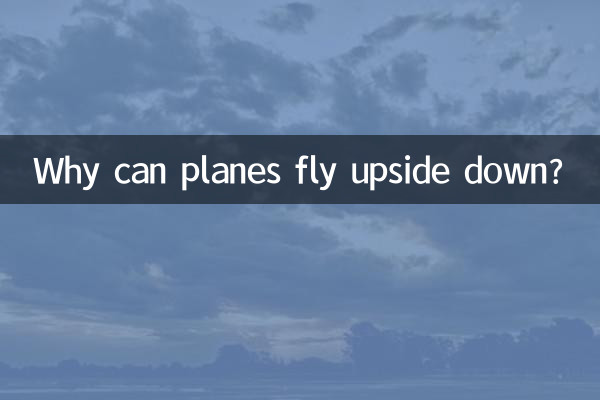Why can planes fly upside down? Revealing the principles of aerobatics in aviation
In recent years, with the popularity of aviation performances and aerobatics, the difficult maneuver of flying an airplane upside down has attracted a lot of attention. Many people are curious: Why can planes fly upside down in the sky? This article will analyze this magical phenomenon for you from the perspective of aerodynamics and aircraft design based on recent hot aviation topics.
1. Review of recent hot topics in the aviation field (last 10 days)

| Date | hot topics | heat index |
|---|---|---|
| 2023-11-15 | Dubai air show aerobatic display | 9.2/10 |
| 2023-11-14 | New moves of the Chinese Air Force aerobatic team | 8.7/10 |
| 2023-11-12 | Whether civil aircraft can fly upside down has sparked heated debate | 7.5/10 |
| 2023-11-10 | World Aerobatic Championships Concluded | 8.9/10 |
2. Basic principles of inverted flight
It may seem counterintuitive for an airplane to fly upside down, but it actually follows strict aerodynamic principles. Key factors include:
| elements | function | Changes during inverted flight |
|---|---|---|
| wing shape | generate lift | Adjust angle of attack in reverse direction |
| flight speed | maintain lift | Sufficient airspeed must be maintained |
| pilot controls | control posture | Reverse operation control surface |
| fuel system | Continuous fuel supply | Requires special design |
3. The difference between aerobatic aircraft and ordinary aircraft
Not all aircraft can be safely flown upside down. Aerobatic aircraft have the following special designs:
1.Symmetric airfoil: The wings of ordinary passenger aircraft are asymmetrical up and down, while aerobatic aircraft usually adopt a symmetrical design and can generate sufficient lift in both forward and inverted flight.
2.Powerful engine: When flying upside down, it needs to overcome gravity and requires more power.
3.special fuel system: Fuel can still be supplied to the engine normally during inverted flight.
4.strengthen structure: To withstand the additional stress during inverted flight.
4. Technical Difficulties of Inverted Flying
| Difficulty | Description | solution |
|---|---|---|
| Lift maintenance | During inverted flight, the direction of lift is opposite | Increase angle of attack and speed |
| spatial orientation | Pilot's sense of direction is confused | specialized training |
| Oil supply system | Fuel may not reach the engine | Inverted fuel tank design |
| manipulative habits | The control surface operates in reverse | muscle memory training |
5. Practical application of inverted flight
Although it may seem like a performance sport, inverted flying also has important value in actual combat:
1.air combat maneuver: Many aerial combat aces in history have used inverted flight techniques to escape pursuit or occupy a favorable position.
2.air show: A great way to demonstrate pilot skills and aircraft performance.
3.pilot training: Exercise the pilot’s ability to control abnormal postures.
6. Safety precautions for inverted flight
Flying upside down is a high-risk maneuver and must be strictly followed:
- Can only be performed on specially designed aircraft
- Must maintain sufficient height
- Requires professional training and qualifications
- Not suitable for passenger flights
Conclusion
The plane flying upside down demonstrates the wisdom and courage of mankind to conquer the sky. With the development of aviation technology, more flying actions that seem to "violate the laws of physics" may be realized in the future. Understanding the scientific principles behind these phenomena not only satisfies our curiosity, but also gives us a deeper understanding and respect for the aviation industry.

check the details

check the details